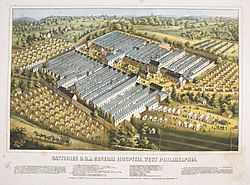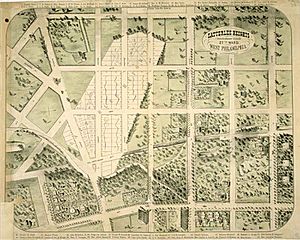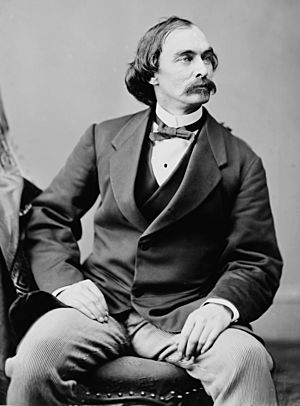Satterlee General Hospital facts for kids
Quick facts for kids Satterlee General Hospital |
|
|---|---|
| Forty-fourth Street and Baltimore Avenue, Philadelphia, Pennsylvania | |

1864 illustration
|
|
| Site information | |
| Controlled by | Union Army |
| Site history | |
| Built | 1862 |
| In use | 1862–1865 |
| Demolished | 1865 (officially closed on August 3, 1865) |
| Battles/wars | American Civil War |
Satterlee General Hospital was a very large hospital for the Union Army during the American Civil War. It operated from 1862 to 1865 in Philadelphia, Pennsylvania. Doctors and nurses there cared for thousands of Union soldiers and Confederate prisoners.
After big battles like Bull Run and Gettysburg, many wounded soldiers needed help. Satterlee Hospital became the second-largest hospital in the country. It had 34 wards and hundreds of tents, holding 4,500 beds.
The hospital was first called West Philadelphia General Hospital. It was later renamed to honor Richard Sherwood Satterlee. He was a doctor who served in the United States Army. During the Civil War, he was promoted to high ranks like brigadier general. This was because he worked hard to get army supplies and managed money carefully.
Building a Big Hospital
The hospital was started in 1862 by Surgeon-General William Alexander Hammond. It was built in West Philadelphia, a less developed area. The hospital grounds covered about 15 acres.
The first part of the hospital had 2,500 beds. It was built very quickly, in just 40 days! This was a huge effort for the time.
Who Worked at Satterlee?
Nurses at Satterlee Hospital were members of the Daughters of Charity of Saint Vincent de Paul. They started working even before the hospital was fully ready. Over 100 Daughters of Charity worked there. They lived in a convent on the hospital grounds. Sister Mary Gonzaga Grace was their leader.
The hospital's main leader was Dr. Isaac Israel Hayes. He was from Chester County, Pennsylvania. Dr. Hayes was famous as an Arctic explorer before he became an army surgeon. He had gone on expeditions to the Arctic in search of the Open Polar Sea.
Father Peter McGrane was the hospital's chaplain. He was a pastor from St. Patrick's church. He helped patients with religious services every day. Archbishop James Wood also visited the hospital often.
Life at the Hospital
In 1862, the hospital added many military tents with beds. This was to help all the soldiers wounded in the Second Battle of Bull Run. The hospital quickly grew to handle the large number of patients.
By 1863, Satterlee Hospital was like a small city on its own. After the Battle of Gettysburg in July 1863, the hospital saw its busiest time. More than 6,000 wounded people were admitted in one month. That August, the hospital recorded the most deaths in a single month.
The hospital needed a lot of supplies to feed everyone. In just one year, patients ate over 800,000 pounds of bread. They also used 16,000 pounds of butter and 334,000 quarts of milk!
By 1864, a 14-foot tall fence surrounded the hospital. It had many useful places inside. There was a barber shop, a carpenter shop, and a clothing store. It also had three kitchens, a laundry, a library, and a post office. There was even a printing office that made the hospital's own newspaper, The Hospital Register.
During its time, Satterlee's doctors and nurses treated about 50,000 sick and wounded people. Only 260 of them died. This was a great achievement, especially considering the medical knowledge and conditions of that time. Sister Ann Alexis Shorb was the head nurse.
After the Confederate army surrendered at Appomattox on April 9, 1865, fewer patients came to Satterlee. The hospital officially closed on August 3, 1865. The buildings were later taken down. In the 1890s, homes were built on much of the land. Part of the hospital grounds is now Clark Park.




